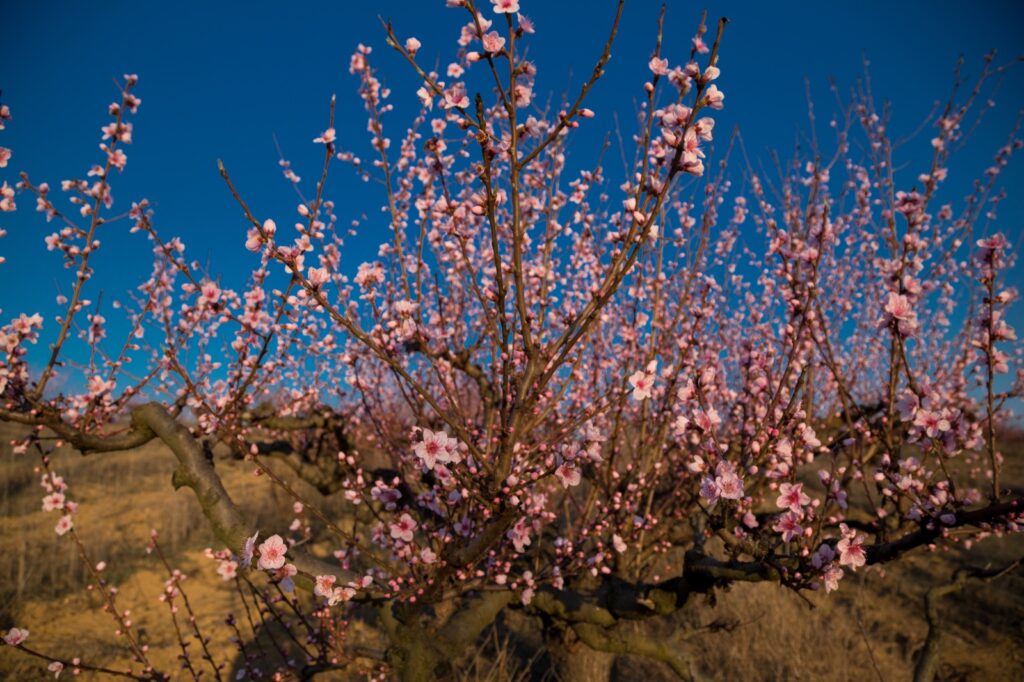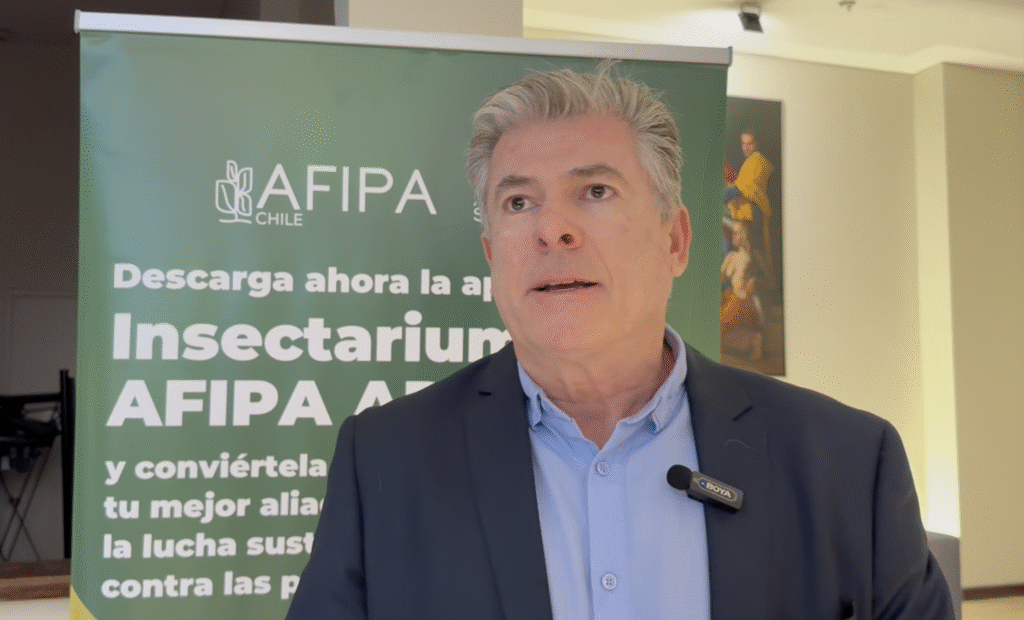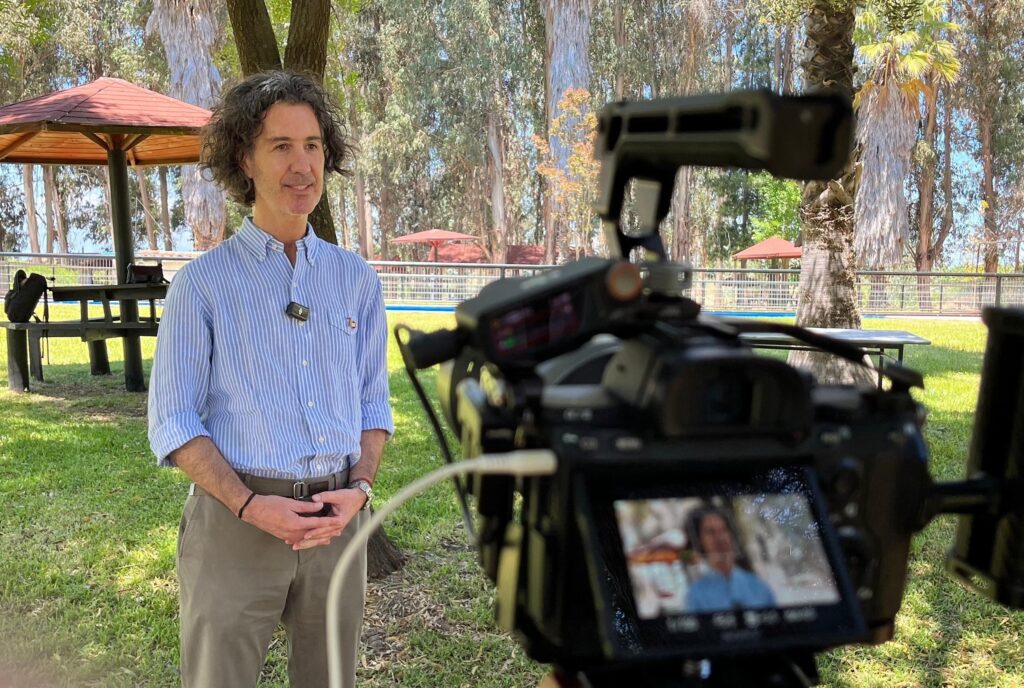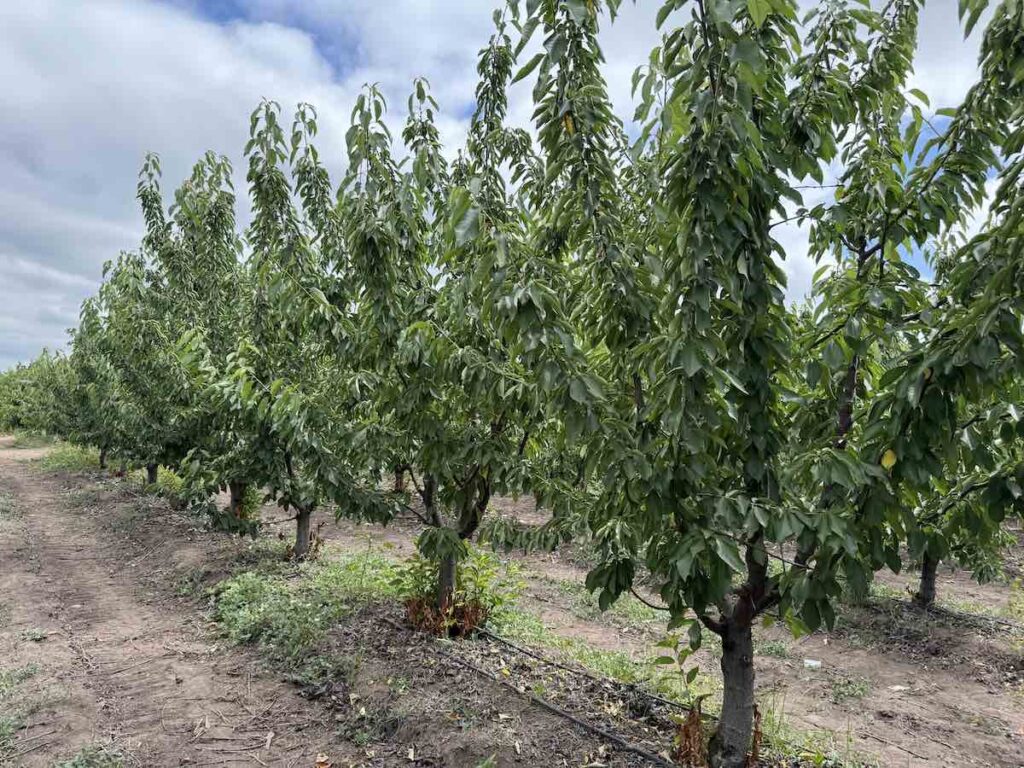Just as when a person gets ready for bed and performs a series of tasks before resting, cherry orchards must also meet certain conditions for a correct winter dormancy. The difference is that they cannot do it on their own, so finishing foliar and soil nutrition programs and suspending irrigation in time is essential for a proper entry into dormancy.
As the days go by and the scene begins to change in the cherry orchards, where the greenery of post-harvest is replaced by the yellow leaves of autumn, many of them already on the ground or about to fall, we face a new stage within the phenological development cycle of the cherry tree: dormancy.
However, this winter dormancy of the plants will depend directly on what happens in the orchard after harvest, on the agronomic management and the signals given to the plants; the concept of post-harvest does not refer, particularly, to the moment after the harvest has finished, but to the post-harvest of the trees, to a physiological change of the plant. The physiological post-harvest responds to some ecological stimulus and is comprised, more or less, between 80 to 150 days after full bloom (DDPF).
It is extremely important to be concerned and take care of the post-harvest stage, especially its first part, and to understand that it has a beginning and an end, taking advantage of it to give way to a stage prior to dormancy, where we have to provide some information to the plant in terms of signals so that it understands that it is going to sleep.
By March, the transition month between post-harvest and dormancy, all orchard recovery programs must be completed, from a nutritional, soil and root point of view. In addition, all foliar corrections must be completed in response to the analyses that were carried out at the beginning of the post-harvest stage.
… It’s time to sleep
Dormancy is understood as the winter lethargy of plants, in which the accumulation of cold hours occurs, which is directly related to the use of the reserves that the trees have to start the following season, in favor of the productive objective of achieving their potential in terms of quantity, quality and condition of fruit.
The beginning of this stage can be defined in several ways, so it is essential to analyse it from both a physiological and theoretical point of view. Physiologically, the tree begins its dormant state when it reaches 50% of its fallen leaves (Fig. 1), in autumn, and we have to try to make it coincide with May 1, because that is when the official count of cold hours begins, which will extend between the months of May and July.
Late season irrigation scheduling and management
As we have already mentioned, one of the signals that we must give to the plants in post-harvest for a correct entry into dormancy is related to irrigation; it must always be taken into consideration, but especially in this phase, that efficient irrigation is not only related to the quantity of water supplied based on consumption, but also to a concept as a whole, which is the distribution of this; special attention must be paid not only to the quantity of water to be replaced in terms of evapotranspiration demand, but also to this decrease from the volumetric point of view of the soil, of the roots of the different rootstocks.
As a general recommendation for programming and managing irrigation towards the end of the season, irrigation should end by March 31, in order to generate a signal to the plant and start the process of lignification of wood and fruit centers, thereby ensuring an acclimatized and “hardened” plant, which will allow it to better withstand low winter temperatures. For soil conditions with lower water retention, such as sandy soils and soils with the presence of stones, irrigation should be extended until April 10.
In this area, there are a number of aspects that must be considered:
-Atmospheric demand and water consumption of the plant are decreasing towards the end of February.
-Demand is expressed in evapotranspiration and not in ambient temperature, which is why high temperatures in March or April are not comparable to those in the summer period, as they only last a couple of hours.
-Starting in March, nights and mornings are colder and more humid, which should be considered for reducing the frequency of irrigation towards the month of March.
– The change in irrigation frequency (not time), under normal conditions, should
decrease between 30% and 50% of what was established in summer towards the third week of March.
The question we always ask ourselves regarding risk management and reprogramming is: Can we water again? And the answer is yes, but in special situations, for example at the beginning of autumn and beginning of winter that is very dry, but never when physiological dormancy is recognized, represented as at least 50% of fallen leaves (yellow leaf = fallen leaf).
Ecological signs
The first important sign that declares dormancy is the change of season; the summer solstice, which normally occurs between December 20-22, marks a very important moment in the beginning of the lignification and pre-dormancy processes, and this is defined in physiology as “cold tolerance”.
When there is a change in the photoperiod, annual materials that grow from the end of September and develop for about 70 days already have lignified basal sections, it is already possible to notice wood and this is a clear sign of the shortening of the photoperiod and affects the beginning of the induction of flowers. With the shortening of the photoperiod, the plant enters a process of accumulation of reserves, change of sap flow and goes to the concept of preparing for dormancy.
Another ecological event that enhances and ensures dormancy is the first autumn frost, and this concept in the physiology of fruit plants is called “freeze resistance”, that is, there is already development of wood, of secondary growth; this is the trigger for the plant to shed its leaves, enter a powerful autumn situation and go to sleep voluntarily.
What should we see in cherry plants before they enter dormancy? Fruit centers with very well-formed stalks, with their bracts very smooth, still with the presence of leaves, since it should be noted that the buds are always axillary to the leaves. Also, ideally by May 1, 50 percent of the leaves have fallen, considering that yellow leaves equal fallen leaves.
The concern that plants enter the dormant period at this time lies mainly in ensuring that all the structures of these are very acclimatized and lignified to withstand the winter and there are no imbalances from the point of view of loss of potential and also phytosanitary. On the other hand, because these processes of the plant at that time require a change ofswitch, because if it enters a more permanent vegetative cycle, the balance or dynamics of reserve recovery is negative; what the plant can produce in carbohydrates at that date is much lower than the carbohydrate consumption rate, therefore the differential is being taken from the same reserves that were obtained in post-harvest.
If the plants enter dormancy on May 1st, this will allow them to take full advantage of winter lethargy, considering June as the most important month in terms of cold hour accumulation. However, it should be noted that good dormancy is not only determined by the accumulation of cold, but also by how short the photoperiod is, i.e. how much light there is.
As we have pointed out, for a correct entry into dormancy it is necessary to take advantage of January and February to carry out all the nutritional recovery, both foliar and soil, and to think about stopping the nutritional programs at the beginning of March, since continuing to provide nutrients via soil or foliar does not allow giving a clear signal to the plant that it will soon have to go to sleep. In addition, March should be considered as the transition month from the point of view of irrigation, ending this work.
But what to do if these two strategies do not provide a response? If by April 20, considering a grace period, our orchards do not present 10-20 % of yellow leaves, decisions must be made on how to accelerate this process.
Option 1: Natural Signal
A natural signal is the use of Ethylene as an Abscisic Acid promoter which, in turn, promotes leaf fall. It should be applied early in the season, in mid-March, however it should be considered that it will generate some delay in flowering, which may or may not be beneficial, depending on the characteristics of the variety, the area and the commercial objective.
On the other hand, it is necessary to keep in mind that a plant subjected to biotic or abiotic stress generates Ethylene, therefore it is an action that must have basic considerations; in orchards that are not in optimal phytosanitary conditions, carry out indiscriminate applications of Ethylene to promote acclimatization and leaf fall.
It is interesting that this technique continues to be studied in order to fine-tune it and adjust it for correct use.
Option 2: Acclimatization
A few years ago, Molybdenum appeared from a nutritional point of view as a good acclimatizer; in its nutritional nature it is part of the metabolic processes of nitrogen, which allows generating responses in decreasing the rate of development in spring and acclimatization in autumn or at the beginning of winter. The objective of Molybdenum is to harden wood and acclimatize and it will respond to a successive application program, three or four applications every 7 days, from mid or late March onwards, so that in the second half of April it has a clear effect on the plants.
Option 3: Poisoning (Zn Sulfate 2% + Urea 2%)
It is a measure that should be considered as a last resort, it cannot be taken before April 15-20; it is a very helpful option and a quick response to leaf fall. This is produced by intoxication through Sulfate that will generate the poisoning of the leaf, but it will not fall, however, when mixed with urea at 2%, the decomposition process of the leaf will be accelerated, which will finally generate its fall.
If fertilization has been completed in February and irrigation in March, this third option has a very good effect; however, in very vigorous orchards the application could be repeated for an optimal result.
In conclusion, problems with acclimatisation of plants for their entry into dormancy can lead to a series of negative consequences, including damage to primordia; as we have been able to confirm in work carried out by the R&D team at Avium, the 90% of primordia damage is expressed by the first of July, that is, it is not related to frosts in certain phenological states, such as swollen buds, for example, but rather to acclimatisation. This, in turn, generates loss of potential and can trigger a vicious circle of permanent phytosanitary problems.
The time for winter dormancy is approaching and our plants must have all the signs to acclimatize, prepare to withstand the low winter temperatures and enter a correct dormancy that allows them to accumulate the optimal amount of cold hours, waiting for the spring kiss that will awaken them for a new productive season.








